Related Research Articles

Chaos theory is an interdisciplinary area of scientific study and branch of mathematics focused on underlying patterns and deterministic laws of dynamical systems that are highly sensitive to initial conditions, and were once thought to have completely random states of disorder and irregularities. Chaos theory states that within the apparent randomness of chaotic complex systems, there are underlying patterns, interconnection, constant feedback loops, repetition, self-similarity, fractals, and self-organization. The butterfly effect, an underlying principle of chaos, describes how a small change in one state of a deterministic nonlinear system can result in large differences in a later state. A metaphor for this behavior is that a butterfly flapping its wings in Texas can cause a tornado in Brazil.

A simple machine is a mechanical device that changes the direction or magnitude of a force. In general, they can be defined as the simplest mechanisms that use mechanical advantage to multiply force. Usually the term refers to the six classical simple machines that were defined by Renaissance scientists:

A machine is a physical system using power to apply forces and control movement to perform an action. The term is commonly applied to artificial devices, such as those employing engines or motors, but also to natural biological macromolecules, such as molecular machines. Machines can be driven by animals and people, by natural forces such as wind and water, and by chemical, thermal, or electrical power, and include a system of mechanisms that shape the actuator input to achieve a specific application of output forces and movement. They can also include computers and sensors that monitor performance and plan movement, often called mechanical systems.

Biomechanics is the study of the structure, function and motion of the mechanical aspects of biological systems, at any level from whole organisms to organs, cells and cell organelles, using the methods of mechanics. Biomechanics is a branch of biophysics.

A gimbal is a pivoted support that permits rotation of an object about an axis. A set of three gimbals, one mounted on the other with orthogonal pivot axes, may be used to allow an object mounted on the innermost gimbal to remain independent of the rotation of its support. For example, on a ship, the gyroscopes, shipboard compasses, stoves, and even drink holders typically use gimbals to keep them upright with respect to the horizon despite the ship's pitching and rolling.

A Reuleaux triangle is a curved triangle with constant width, the simplest and best known curve of constant width other than the circle. It is formed from the intersection of three circular disks, each having its center on the boundary of the other two. Constant width means that the separation of every two parallel supporting lines is the same, independent of their orientation. Because its width is constant, the Reuleaux triangle is one answer to the question "Other than a circle, what shape can a manhole cover be made so that it cannot fall down through the hole?"
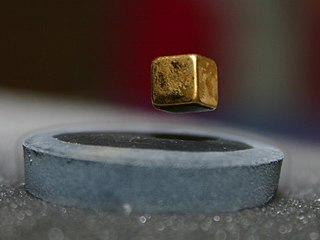
Levitation is the process by which an object is held aloft in a stable position, without mechanical support via any physical contact.
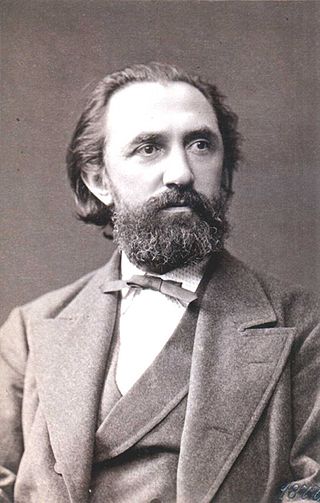
Franz Reuleaux, was a German mechanical engineer and a lecturer of the Berlin Royal Technical Academy, later appointed as the president of the academy. He was often called the father of kinematics. He was a leader in his profession, contributing to many important domains of science and knowledge.
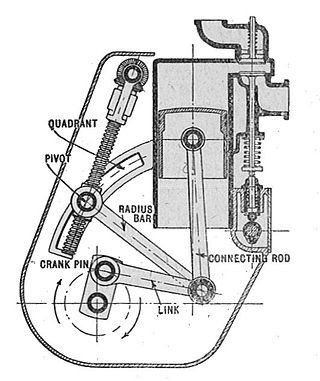
A mechanical linkage is an assembly of systems connected to manage forces and movement. The movement of a body, or link, is studied using geometry so the link is considered to be rigid. The connections between links are modeled as providing ideal movement, pure rotation or sliding for example, and are called joints. A linkage modeled as a network of rigid links and ideal joints is called a kinematic chain.
Applied mechanics is the branch of science concerned with the motion of any substance that can be experienced or perceived by humans without the help of instruments. In short, when mechanics concepts surpass being theoretical and are applied and executed, general mechanics becomes applied mechanics. It is this stark difference that makes applied mechanics an essential understanding for practical everyday life. It has numerous applications in a wide variety of fields and disciplines, including but not limited to structural engineering, astronomy, oceanography, meteorology, hydraulics, mechanical engineering, aerospace engineering, nanotechnology, structural design, earthquake engineering, fluid dynamics, planetary sciences, and other life sciences. Connecting research between numerous disciplines, applied mechanics plays an important role in both science and engineering.
In classical mechanics, a kinematic pair is a connection between two physical objects that imposes constraints on their relative movement (kinematics). German engineer Franz Reuleaux introduced the kinematic pair as a new approach to the study of machines that provided an advance over the motion of elements consisting of simple machines.
Ali Hasan Nayfeh was a Palestinian-Jordanian mathematician, mechanical engineer and physicist. He is regarded as the most influential scholar and scientist in the area of applied nonlinear dynamics in mechanics and engineering. He was the inaugural winner of the Thomas K. Caughey Dynamics Award, and was awarded the Benjamin Franklin Medal in mechanical engineering. His pioneering work in nonlinear dynamics has been influential in the construction and maintenance of machines and structures that are common in daily life, such as ships, cranes, bridges, buildings, skyscrapers, jet engines, rocket engines, aircraft and spacecraft.

Vittorio Zonca (1568–1603) was an Italian engineer and writer. He wrote the Theater of machines, which was published in Padua in 1607 four years after his death.

Marco Amabili is a professor who holds the Canada Research Chair in Vibrations and Fluid-Structure Interaction, Department of Mechanical Engineering at McGill University, Montreal, Québec, Canada.

Edward Ott is an American physicist most noted for his contributions to the development of chaos theory.
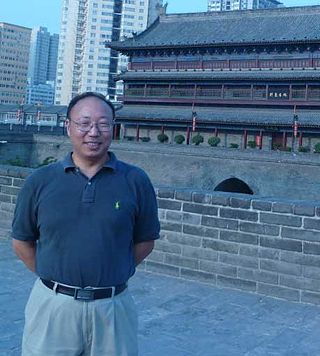
Albert C.J. Luo is a distinguished research professor of mechanical engineering at Southern Illinois University, Edwardsville, Illinois. Luo is an internationally recognized scientist in the field of nonlinear dynamics and mechanics. His principal research interests lie in the field of Hamiltonian chaos, nonlinear mechanics, and discontinuous dynamical systems.

John Michael Tutill Thompson, born on 7 June 1937 in Cottingham, England, is an Honorary Fellow in the Department of Applied Mathematics and Theoretical Physics at the University of Cambridge. He is married with two children.
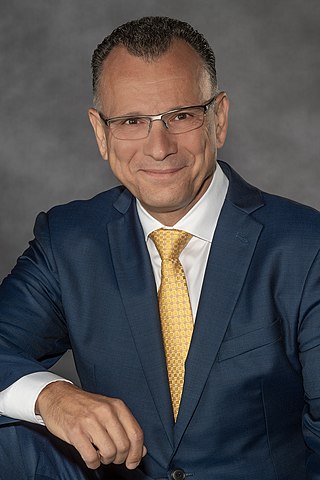
Fotis Sotiropoulos is a Greek-born American engineering professor and university administrator known for his research contributions in computational fluid dynamics for river hydrodynamics, renewable energy, biomedical and biological applications. He currently serves as the Provost and Senior Vice President for Academic Affairs of Virginia Commonwealth University, a position he has held since August 1, 2021
Amitabha Ghosh is an Indian researcher, administrator and educator. He currently holds the position of Honorary Scientist, Indian National Science Academy and Honorary Distinguished Professor in the Aerospace Engineering and Applied Mechanics Department at the Indian Institute of Engineering Science and Technology, Shibpur, Howrah, West Bengal. He is an Emeritus Senior Fellow of the Alexander von Humboldt Foundation and a Fellow of The National Academy of Sciences, India, of which he was elected a Senior Scientist Platinum Jubilee Fellow in 2012. Ghosh has made contributions in various fields, including fundamental and applied research, technology development, administration and social development.

Ezra Cornell is a monumental statue in Ithaca, New York, United States. Located on the Arts Quad of the Cornell Central Campus, the monument honors Ezra Cornell, the co-founder and namesake of Cornell University. The statue, designed by Hermon Atkins MacNeil, was dedicated in 1919.
References
- 1 2 "Francis Charles Moon". Sibley College and School of Mechanical Engineering, Cornell University. Retrieved 24 September 2023.
- ↑ Moon, Francis C. (15 January 2015). "A Brief History of the Sibley College and School". Sibley College and School of Mechanical Engineering, Cornell University. Retrieved 24 September 2023.
- ↑ "Moon, Francis C." Cornell University Library. Retrieved 24 September 2023.
- ↑ "Dr. Francis Charles Moon". United States National Academy of Engineering. Retrieved 24 September 2023.
- ↑ Gollub, Jerry P. (May 1989). "Chaotic Vibrations: An Introduction for Applied Scientists and Engineers". Physics Today. 42 (5): 78. doi:10.1063/1.2811021.
- ↑ El Naschie, M. S. (March 2000). "Chaotic and Fractal Dynamics; Francis C. Moon; Wiley, New York, 1992". Chaos Solitons and Fractals. 2 (4): 642. Bibcode:2000CSF....11..642E. doi:10.1016/S0960-0779(99)00034-X.
- ↑ Keller, Alexander G. (2009). "The Machines of Leonardo da Vinci and Franz Reuleaux: Kinematics of Machines from the Renaissance to the 20th Century (review)". Technology and Culture. 50 (2): 454–456. doi:10.1353/tech.0.0247. S2CID 108767784. ResearchGate : 254964717